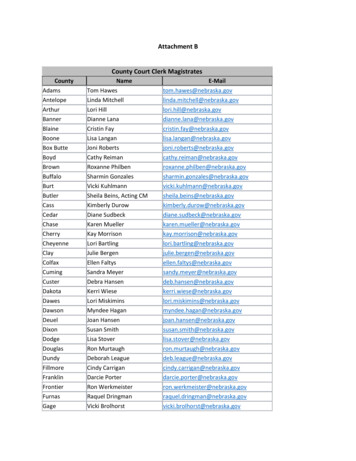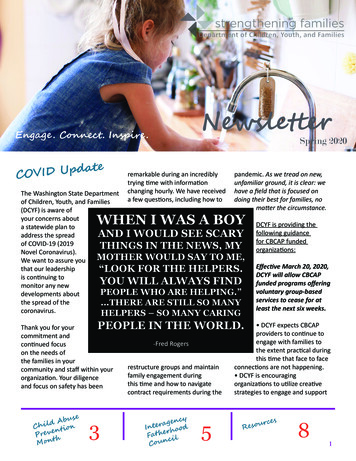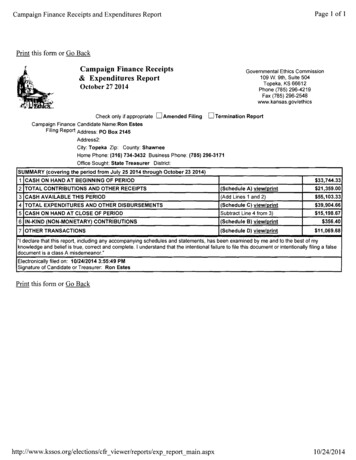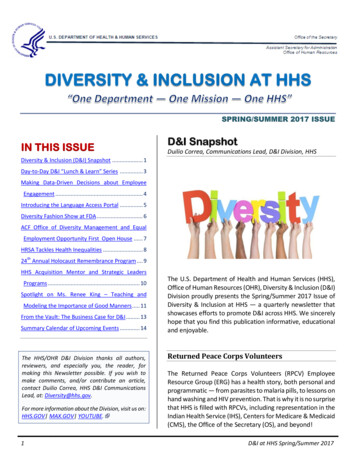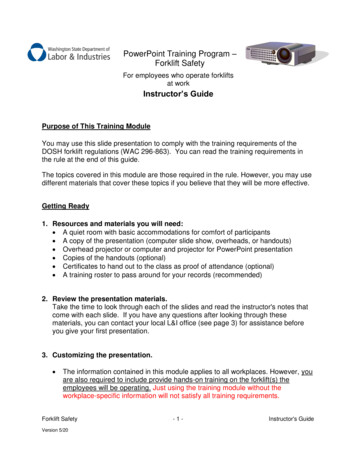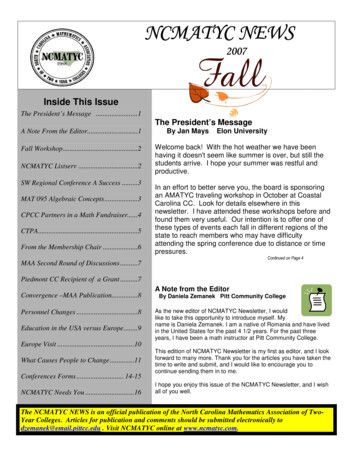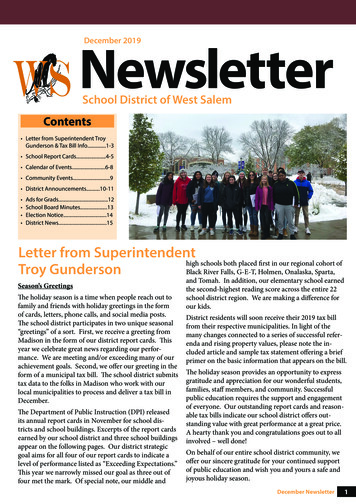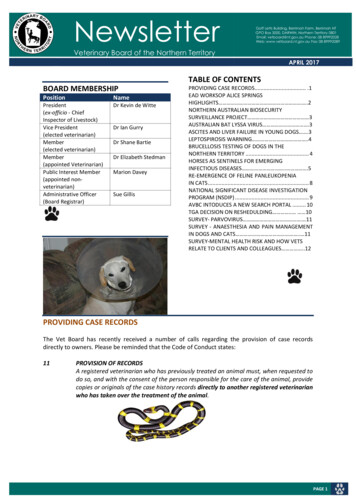
Transcription
NewsletterGoff Letts Building, Berrimah Farm, Berrimah NTGPO Box 3000, DARWIN, Northern Territory 0801Email: vetboard@nt.gov.au Phone: 08 89992028Web: www.vetboard.nt.gov.au Fax: 08 89992089Veterinary Board of the Northern TerritoryAPRIL 2017TABLE OF CONTENTSBOARD MEMBERSHIPPositionNamePresident(ex-officio - ChiefInspector of Livestock)Vice President(elected veterinarian)Member(elected veterinarian)Member(appointed Veterinarian)Public Interest Member(appointed nonveterinarian)Administrative Officer(Board Registrar)Dr Kevin de WitteDr Ian GurryDr Shane BartieDr Elizabeth StedmanMarion DaveySue GillisPROVIDING CASE RECORDS. .1EAD WORKSOP ALICE SPRINGSHIGHLIGHTS .2NORTHERN AUSTRALIAN BIOSECURITYSURVEILLANCE PROJECT 3AUSTRALIAN BAT LYSSA VIRUS .3ASCITES AND LIVER FAILURE IN YOUNG DOGS .3LEPTOSPIROSIS WARNING .4BRUCELLOSIS TESTING OF DOGS IN THENORTHERN TERRITORY . 4HORSES AS SENTINELS FOR EMERGINGINFECTIOUS DISEASES . .5RE-EMERGENCE OF FELINE PANLEUKOPENIAIN CATS . 8NATIONAL SIGNIFICANT DISEASE INVESTIGATIONPROGRAM (NSDIP) . 9AVBC INTODUCES A NEW SEARCH PORTAL . 10TGA DECISION ON RESHEDULDING . 10SURVEY- PARVOVIRUS . 11SURVEY - ANAESTHESIA AND PAIN MANAGEMENTIN DOGS AND CATS . 11SURVEY-MENTAL HEALTH RISK AND HOW VETSRELATE TO CLIENTS AND COLLEAGUES .12PROVIDING CASE RECORDSThe Vet Board has recently received a number of calls regarding the provision of case recordsdirectly to owners. Please be reminded that the Code of Conduct states:11PROVISION OF RECORDSA registered veterinarian who has previously treated an animal must, when requested todo so, and with the consent of the person responsible for the care of the animal, providecopies or originals of the case history records directly to another registered veterinarianwho has taken over the treatment of the animal.PAGE 1
VETERINARY BOARD OF THE NORTHERN TERRITORY - NEWSLETTEREAD WORKSHOP HIGHLIGHTS OF ABLV CASE BY DR ED ANNANDThe Northern Territory Department of Primary Industries together with the Department ofAgriculture and Water Resources held a very successful Emergency Animal Disease workshop forveterinarians at the Arid Research Station in Alice Springs in April. This one day workshop was similarto the event held in Darwin in November 2016 and provided the opportunity for the 14 veterinariansthat attended to enhance their knowledge and skills in emergency disease recognition andinvestigation.Guest speakers included Dr Ed Annand from Sydney University presenting an interesting case ofAustralian Bat Lyssavirus (ABLV) in two horses that progressed to death in 54 hours following initialHendra virus (HeV) negative results. These two diseases are believed to represent a significant risk inthe NT and are of particular interest to both large and small animal practitioners.The take home messages from this presentation included: We are surrounded by flying fox and micro bats in the NT. There are 65 species of micro batin Australia – it is just a matter of time before further ABLV cases are seen.Horses may present with a wide range of clinical signs that may be vague and non-specificfor a neurological case such as lameness, mild hyperaesthesia, mild colic, ataxia, andintermittent behavioural changes.The importance of establishing a detailed differential diagnosis list and the need to considerABLV as an alternative diagnosis for HeV negative animals with progressive symptoms.The value of taking some samples (minimum of EDTA blood, nasal swabs) early in a case,especially in remote areas, for future diagnosis and post exposure prophylaxis.In a dead horse, neck skin biopsies of hair follicles and their associated cutaneous nerves canbe examined using immunofluorescence.The importance of good communication with government veterinarians, health officials, andlaboratories.For all veterinarians to use appropriate PPE and to consider pre-exposure rabies vaccinationfor all veterinary staff.To date there have been 3 fatal ABLV human cases in Australia, all of which have involved directcontact with a bat. ABLV should be considered as a differential diagnosis in all domestic animalsdisplaying progressive neurological signs in Australia. There is an ongoing need to generateawareness in the horse owning public on the necessity to adopt good personal hygiene and wearPPE.PAGE 2
VETERINARY BOARD OF THE NORTHERN TERRITORY - NEWSLETTERNORTHERN AUSTRALIAN BIOSECURITY SURVEILLANCE PROJECTThe Northern Australian Biosecurity Surveillance project has been funded under the DevelopingNorthern Australia and the Agricultural Competitiveness White Papers to manage new and growingbiosecurity risks in Northern Australia. Under this project, post-mortem sampling consumables kitsare being distributed to major cattle properties in the NT. The kits are designed to be kept on-handby properties, to assist vets and others performing disease investigations in remote areas. There arespecific containers for screw worm fly maggots as well as a full range of containers and FLOQ swabs.AUSTRALIAN BAT LYSSA VIRUS (ABLV) DIAGNOSED IN A FLYING FOXIn December 2016, ABLV was confirmed in a little red flying fox from the Darwin rural area. This isonly the fourth reported case of ABLV in a bat in the NT. In this case, a dog which may have beenscratched by the bat received post-exposure prophylaxis, as well as in contact with people and dogs.ABLV has an incubation period of potentially many years. The major disease risk period (60 days) fordisease incubation has now passed but the extreme end-point might be 10 years away. It is hopedthat future risk of disease developing is minimal. Berrimah Veterinary Laboratory will accept anyundiagnosed neurological cases for post mortem in the interests of public health. DPIR holds stocksof Nobivac Rabies vaccine, available on request.For further information, please contact Elizabeth Stedman Veterinary Officer DPIR on 8999 2035.All veterinarians should be familiar with the NT ABLV Guidelines for Veterinarians.Further resources for veterinarians and pet owners are available t-lyssavirus-and-your-petABLV is a notifiable disease, and any suspicion of ABLV must be immediately reported to the ChiefVeterinary Officer on 8999 2130.ASCITES AND LIVER FAILURE IN YOUNG DOGS IN THE DARWIN AREA- UPDATEA number of cases of unexplained ascites and liver disease in young dogs in the Darwin rural areawere reported in late 2016. No cases have been reported since November 2016. If you suspect youhave seen a case of unexplained ascites or liver disease in young dogs, please contact the ElizabethStedman Veterinary Officer on 8999 2035. Laboratory investigation for relevant cases may beperformed by the Berrimah Veterinary Laboratories free of charge.PAGE 3
VETERINARY BOARD OF THE NORTHERN TERRITORY - NEWSLETTERLEPTOSPIROSIS WARNINGInfection with Leptospira pomona has recently been confirmed in stock workers who handled cattleon top end flood plains during the wet season. A number of workers have been severely ill andfortunately all have recovered. Animal cases of leptospirosis are not commonly reported in theNT. In this case, 30 cattle sampled demonstrated high sero-conversion rates primarily to L. Pomonabut no clinical leptospirosis was seen.Differential diagnoses for leptospirosis in people in northern Australia may include a number ofshared diseases which vets should be aware of, such as; Brucellosis (B. suis)InfluenzaMycoplasmaQ feverLegionellaMelioidosis (environmental mostly)RickettsiaPsittacosisArboviruses, including Ross River Virus and Barmah Forest virusIf you have been sick or know someone who has been; then convalescent serology is required todiagnose the cause. Melioidosis is an important exclusion requiring further treatment. Contact yourgeneral practice doctor.BRUCELLOSIS TESTING OF DOGS IN THE NORTHERN TERRITORYBrucella suis (B. suis) is a zoonotic disease widespread in feral pig populations throughoutQueensland and northern New South Wales. B. suis has not been detected in the NorthernTerritory feral pig population but it is suspected to be present. B. suis is transmitted to dogsduring pig hunting activities and by feeding raw feral pig meat and by-products. It issuspected that young dogs with no history of pig hunting may contract B. suis at the time ofbirth from an infected bitch. Infection may also be passed between dogs during mating andclose contact.Brucellosis presents a major zoonotic risk for people and veterinarians in contact withinfected dogs. The Northern Territory Department of Primary Industry and Resources (DPIR)and the Berrimah Veterinary Laboratory (BVL) are seeking to establish if B. suis is present inthe Northern Territory dog and pig population.PAGE 4
VETERINARY BOARD OF THE NORTHERN TERRITORY - NEWSLETTERPrivate veterinarians who are presented with dogs or pigs with suspected clinical signs and ahistory of associated risk factors are asked to submit samples to the BVL for B. suis exclusiontesting. The Rose Bengal test will be performed as an initial rapid screening test.For further information see below link: for-veterinariansHORSES AS SENTINELS FOR EMERGING INFECTIOUS DISEASES – A STUDY INIMPROVED DIAGNOSIS OF HORSE ILLNESSSignificant numbers of horses in Australia are clinically affected each year from respiratoryand/or encephalitis related disease and the cause of their illnesses/death remainsundiagnosed. There is a direct parallel to similar undiagnosed syndromes in humanmedicine.Many of these equine cases display signs consistent with Hendra virus (HeV) infection.Although the transmission of HeV to horses from flying foxes is not fully understood, thesame transmission pathway could be resulting in spillover of other viruses from flying foxesand/or insectivorous bats. As horses act as amplifying hosts for HeV they could also act assentinels for other potentially zoonotic virus spill overs. Australian Bat Lyssavirus (ABLV) isnotable in this category.The project will provide much needed additional knowledge for practitioners to clarify thepotential human health risk associated with these illnesses and improve treatment andoutcome for horses which may be compromised by uncertainty surrounding thesepresentations.For a more complete differential diagnosis list of acute severe illness in horses – see the listand table at the end of this article.Aim: To explore the possibility of novel virus spillover to horses that have displayedneurological and or respiratory symptoms including those suggestive of HeV infection, butwhere HeV has been excluded, and there is a lack of a more likely differential diagnosis.Plan: To investigate clinical cases of undifferentiated equine neurological and or respiratorydisease with further testing for known (e.g. ABLV, Flaviviruses, Bunyaviruses, Orbivirusesand Paramyxoviruses) and unknown viruses using serology, PCR and next generationsequencing.The project will run for five years and is a collaboration between the Sydney EquineInfectious Disease Group, University of Sydney; CSIRO Australian Animal Health Laboratory(AAHL); QDAFF Biosecurity Sciences Laboratory Coopers Plains; Berrimah VeterinaryLaboratory (BVL), Northern Territory DPI&R, Elizabeth Macarthur Agricultural InstituteMenangle; VIC DEPI Arbovirus Disease Control Program Melbourne and the Centre forEquine Infectious Disease, University of Melbourne.PAGE 5
VETERINARY BOARD OF THE NORTHERN TERRITORY - NEWSLETTERHow can you help?We invite you to submit samples to BVL from cases of undifferentiated equine neurologicaland or respiratory disease. Interested veterinarians should register their interest with EdAnnand (contact details below). He will then forward you case history forms and samplesubmission instructions. Submissions also need the BVL Specimen Advice Note (SAN).Early safe, sample collection is recommended. This is important for the less pathogenicagents that may already be in decline when clinical signs are shown and for the highlypathogenic agents that may cause rapid death of a horse.Veterinarians should be cautious in a safe sampling approach for undiagnosed progressiveequine illness or equine death – it is recommended not to open the carcase.Samples in cases where HeV exclusion has not been carried out (e.g. HeV vaccinated horseor case not markedly progressive or not notifiable): Nasal and oral swabs in viral transport medium (or saline). EDTA blood Paired serum 10 to 14 days apart. CNS fluid Post mortem samples including neck skin biopsies of hair follicles and theirassociated cutaneous nerves for ABLV immuno-fluorescence testing.Samples for ABLV exclusion testing (PCR tests) may be forwarded from BVL to CSIRO AAHLfollowing HeV exclusion, for example: EDTA and clotted bloodNasal, oral / saliva and rectal swabs (placed into viral transport media or sterilesaline).Don’t forget PPE: The recent delayed onset case of Hendra in a NSW horse reinforces theextremely important need for strict adherence to PPE and good biosecurity even in thosecases where HeV has been excluded. Hendra is a notifiable disease in the NT. Also, yourHendra negative case could be ABLV! See also the Alice Springs workshop report on pagetwo.NT website link: nimal-health-and-diseasesThe study is particularly relevant to the NT and I encourage you to participate whenpossible. For further information contact your local government veterinarian or:Ed Annand BVSc (Hons), MANZCVS(Equine Surgery), Cert AVP (ESM), MRCVS.Sydney Equine Infectious Disease GroupUniversity of Sydney, Camden Equine CentrePh: 0439572329 email: ed.annand@sydney.edu.auPAGE 6
VETERINARY BOARD OF THE NORTHERN TERRITORY - NEWSLETTERDifferential diagnoses for acute severe illness in horsesInfectious: Bacterial meningitis / abscessation; Bacterial pneumonia; Anthrax; Viral infection(encephalitis / meningitis, vasculitis, severe respiratory)##; Mycotic infection - particularlyCryptococcus (pneumonia / encephalitis); Equine protozoal myeloencephalitis*/ Amoebicencephalitis*; Trypanosomiasis* #* Not known to occur in Australia.# Surra (Trypanosoma evansi) is not found in Australia but is endemic in our close neighbours. Nativetrypanosome species are of unknown presence or clinical significance in horses.## See tables for viruses potentially involved in acute equine illness.Colic due to acute abdomen conditionsToxicity: Snake envenomation – brown, tiger, taipan; Tick paralysis – Ixodes holocyclus;Tetanus; Botulism; Metaldehyde; Ergot alkaloidosisPlant toxicities: Avocado; Pyrrolizidine alkaloids (in the NT Crotolaria spp. especially C.crispate); Hepatotoxic encephalopathy; Cardiac Glycosides Eg. Indigofera.Poisons: 1080; Paraquat; Monensin; LeadTrauma: traumatic encephalopathyOther: Cardiac – ruptured chordae tendinae; Metabolic derangement (Hypocalcemia;Hyponatremia; Hypoglycemia); Hypo-/hyperosmolality disorders; HyperammonemiaNeoplastic: Cholesterol granuloma; Adenocarcinoma; Lymphoma; Pituitary adenomaIatrogenic: Air embolism; Intra-carotid injection; Drug overdoses (Moxidectin,Metronidazole, Trimethoprim sulphonamide, Lignocaine)Case features / Symptoms that may increase the suspicion of infectious cause includepyrexia, respiratory and or neurological signs as well as multiple cases occurring in apparentepidemiological relationship. In such cases, and where HeV testing is negative the followingviruses already detected in Australia could be involved many of which would pose direct orindirect (arthropod vector) human health threats.VirusGenus / FamilyReservoir/vector Confirmed in:Australian batlyssavirus ABLVMenangle MePVLyssavirus / Rhabdoviridaeall rbivirus / Reoviridaeflying foxesNo#Yesmosquito / culicoidesYesNoNoYesFlavivirus/ FlaviviridaeBirds / mosquitoesYesYesYesYesYesYesElsey ELSV (PHSV)Bluetongue virusBTVMurray valleyencephalitis virusMVEVWest Nile virusWNV (Kunjin) KUNVJapaneseEncephalitis JEVRoss River VirusRRVEquine Herpesviruses1 EHV – 1Alphavirus/ pesvirusHorseYesNo# Equine seropositivity for this or a very closely related virus has recently been identified as part of this research.Further testing is currently underway.PAGE 7
VETERINARY BOARD OF THE NORTHERN TERRITORY - NEWSLETTERThe following viruses are known to cause similar disease in horses internationally.VirusGenus / familyReservoir/vectorNipah NiPVHenipavirus/ParamyxoviridaeLyssavirus/ RhabdoviridaeFlying foxesRabies virus RABVAfrican horsesickness virus AHSEquine Encephalosisvirus EEVPeruvian horsesickness PHSV**Eastern equineencephalitis virusEEEVGetah virus GETVShuni virus SHUVBorna disease virusBDVSt. Louiseencephalitis virusSLEVOrbivirus/ ReoviridaeConfirmed in:HorsesHumansNo*YesTerrestrial carnivoresand batsculicoides, mosquitoesand YesAlphavirus/ TogaviridaeOrthobunyavirus/BunyaviridaeBornavirus/ Bornaviriadaeculicoides, mosquitoesYesYesYesNoRodents suspectedYesYesFlavivirus/ FlaviviridaeBirds / MosquitoesYesYes*A henipavirus outbreak occurred in 2014 in the Philippines that caused fatalities in horses, humans, dogs and a cat and9featured human to human transmission – it is thought to have been very closely related to HeV and NiV**This virus is considered practically identical to ELSV.In addition to the viruses mentioned above the following viruses have been recentlyidentified in Australian bats10 and potentially may follow the same spill over pathway tohorses as HeV with unknown clinical significance.11VirusGenus / familyReservoir/vectorCedar CedPVHervey HerPVGrove GroPVTeviot TevPVYepoon YepPVHenipavirus/ ParamyxoviridaeRubulavirus / ParamyxoviridaeFlying foxesConfirmed in:HorsesHumansno#nononono#nonononono# Equine sero-positivity for this or a very closely related virus has recently been identified as part of this research.Further testing is currently underway.RE-EMERGENCE OF FELINE PANLEUKOPENIA IN CATSFeline pan leukopenia has re-emerged in Australia, with several large outbreaks recordedsince 2014 in Melbourne and Mildura. This is the first time an outbreak of FPV has beenconfirmed in Sydney for many years.There have been two new outbreaks of feline pan leukopenia in Melbourne and Sydney. InNovember 2016 twelve unvaccinated kittens found near Deakin in Melbourne weredistributed to different carers through a private shelter. Clinical signs in affected cats werefever, lethargy, anorexia then vomiting and diarrhoea.PAGE 8
VETERINARY BOARD OF THE NORTHERN TERRITORY - NEWSLETTERSeveral kittens were tested with in-house faecal antigen canine parvovirus (CPV) tests andwere positive.Sequencing of isolates at Professor Vanessa Barrs’ laboratory at the University of Sydney hasconfirmed that disease was caused by a strain of feline pan leukopenia virus (FPV) almostidentical to that detected in an FPV outbreak in shelter-housed cats in Mildura andMelbourne in 2015.Feline pan leukopenia has now struck in Sydney resulting in severe morbidity and deaths ofshelter-housed and owned cats in Sydney. Like the Melbourne outbreaks disease occurredin unvaccinated or incompletely vaccinated cats, mostly in kittens less than 6 months, andespecially in kittens 6 to 12 weeks old. Clinical signs were similar to the Melbourneoutbreak. In addition blood tests identified severe leukopenia due to neutropenia andlymphopenia in a number of cats. DNA sequencing confirmed the outbreak is also due toFPV.The DNA sequences of the FPV strains detected in Australia indicate that current FPVvaccines are protective. FPV vaccines also confer cross-protection against CPV2a-c variants.Modified live vaccines can be safely administered from the age of four weeks, and arerecommended to be administered in the face of an FPV outbreak every two to three weeksuntil 16 weeks of age. Kittens not in a shelter environment should be vaccinated from 6 to 8weeks of age every three to four weeks until 16 weeks of age or older, as per the WSAVAvaccination guidelines.NATIONAL SIGNIFICANT DISEASE INVESTIGATION PROGRAM (NSDIP)The National Significant Disease Investigation Program (NSDIP) aims to enhance Australia scapacity for the early detection of livestock and wildlife diseases through increasing theparticipation of private veterinarians in the investigation of disease events.What is a significant disease event?An eligible disease event includes the following: atypical morbidity, mortality and/or rate of disease spread;clinical signs consistent with an exotic disease without a clear alternative diagnosis;Incidents where an initial investigation fails to establish a diagnosis however findingssuggest the potential for significant trade or market access, farm productivity, public health,or wildlife biodiversity conservation impacts.Subsidies available for veterinariansThis program subsidises the cost of a disease investigation conducted by a privateveterinarian. Subsidies are available for: initial field investigation 225 (local) - 335 (remote)laboratory testing 155PAGE 9
VETERINARY BOARD OF THE NORTHERN TERRITORY - NEWSLETTER follow-up investigation. 225 (local) - 335 (remote).Investigating disease eventsWhen a veterinarian becomes aware of a case which is consistent with the disease event criteria, thevet should contact the Northern Territory NSDIP Co-ordinator Elizabeth Stedman on 8999 2035 toconfirm the availability of an investigation subsidy and discuss arrangements for the investigation.Further information about NSDIP: Animal Health AustraliaProgram.- National Significant Disease InvestigationYour contribution to the national animal health surveillance system is important.Submissions and reports welcomed.AVBC INTRODUCES A NEW SEACH PORTALThe AVBC has produced a new search engine for registered veterinarians in Australia, whichis available to the public at http://avbc.asn.au/search-for-registered-vet/ The below link willtake you to the search engine. The Vet Board of the NT still holds and produces a currentdatabase of all registered veterinarians in the NT which is accessible on the mmittees-and-boards/veterinary-board-of-theNTThe AVBC link is: https://avbc.asn.au/search-for-registered-vet/TGA DECISION ON RESCHEDULING OF PENTOBARBITAL INJECTIONThe Therapeutic Goods Administration (TGA) has released its interim decision thatinjectable pentobarbitone will remain as an S4 (restricted drug) rather than a proposed S8(controlleddrug).This recommendation is in line with the AVA’s submission provided to the TGA in embers.The TGA has also recommended that the state and territory governments slation.YoucanreadmoreabouttheTGAdecisionhere.In the AVA submission, it was stated that the AVA supported greater regulation ofpentobarbital injection including increased storage requirements, a view that membersPAGE 10
VETERINARY BOARD OF THE NORTHERN TERRITORY - NEWSLETTERwidely agreed with. The AVA will be working with all state authorities to ntosupportthis.You should also be aware of your state or territory legislation in relation to how injectablepentobarbitone should be currently stored and recorded.SURVEY - PARVOVIRUSVeterinarians across Australia are being asked to fill in a short survey on Canine Parvovirus.Even veterinarians who do not see the disease are asked to please fill in the survey.It should take less than 10 minutes to complete.The survey is only open for a limited time so please follow the link to fill in the survey assoon as you can.The research is being run through the University of Sydney and is attempting to gauge thetrue national prevalence of the disease which is currently unknown.Veterinarians in areas that see Canine Parvovirus outbreaks will also be able to answer PartTwo of the survey which will help gather important information on bringing the diseaseunder control.With your help, it is hoped that this research will lead to a strategy that will enable CanineParvovirus case numbers to be drastically reduced across Australia, and in the future thatthe disease could even potentially be eradicated. If you have any questions, please feel freeto contact me via email or on my mobile 0417 906 771.Dr Mark Kelman: kelmanscientific@gmail.comMore information, including contact details of the researchers are included when you clickthe link z3i3DbbZwkvWtrNXwQUiAwLPFKM8G4gISURVEY - ANAESTHESIA AND PAIN MANAGEMENT FOR DOGS AND CATSOver the past 10 to 15 years a number of new anaesthetic and analgesic drugs andtechniques have been introduced into small animal veterinary practice. It is the aim of thissurvey to assess how widely these new methods have been accepted by veterinariansthroughout Australia. Therefore we are asking for your support in responding to this requestfor your input into this survey.It is estimated that it take up about 20 minutes of your time and as an inducement we areoffering a reward of an Apple iPad Air or equivalent to one lucky random participant.PAGE 11
VETERINARY BOARD OF THE NORTHERN TERRITORY - NEWSLETTERThis survey is being conducted through the School of Animal and Veterinary Sciences (SAVS)at the University of Adelaide. It has approval from the University of Adelaide HumanResearch Ethics Committee, approval number H-2016-186. If you have questions regardingthis survey please contact: Dr Anthony Nicholson at the SAVS anthony.nicholson@adelaide.edu.au.To participate, please follow this web link: Survey on Anaesthesia & Analgesia(Or go to https://www.surveymonkey.com/r/Anaesthesia Survey) where full details areavailable.RESEARCH SURVEY - MENTAL HEALTH RISK AND HOW VETS RELATE TOCLIENTS AND COLLEAGUESVarious workplace factors are known to affect the mental health and wellbeing of vets. Thisstudy seeks to investigate how vets relate to their colleagues and clients, and aspects ofthese relationships that protect or harm vets’ mental health.It is anticipated this research will provide important practical contributions for vet practiceswhich include:1.Informing vets on suicide risk.2.Guidance on structuring suicide early prevention strategies for practitioners.3.Developing training to facilitate colleague and client interactions that improve staffrelationships and increase client satisfaction.4.Wider application of findings to professions involving a caring role by practitionerse.g., veterinary nurses, doctors, nurses, dentists.Participation involves completing an anonymous online questionnaire which should take nolonger than 30 minutes. This study is confidential and you cannot be identified from yourresponses.Upon completing the survey you can enter a draw for 1 of 10 Coles Group and Myer GiftCards valued at 100 each.All veterinarians registered in Australia, who interact with clients, are encouraged toparticipate. The survey closes on 15 July 2017.You can read further about this research from Murdochwww.practitionermentalhealth.com. The primary contact is:Karen Connell: Email: k.connell@murdoch.edu.au Ph.: 0417 988 991PAGE 12Universityat
Newsletter Goff Letts Building, Berrimah Farm, Berrimah NT GPO Box 3000, DARWIN, Northern Territory 0801 Email: vetboard@nt.gov.au Phone: 08 89992028 Web: www.vetboard.nt.gov.au Fax: 08 89992089 APRIL 2017 PAGE 1 BOARD MEMBERSHIP Position Name President (ex-officio - Chief Inspector of Livestock) Dr Kevin de Witte Vice President

